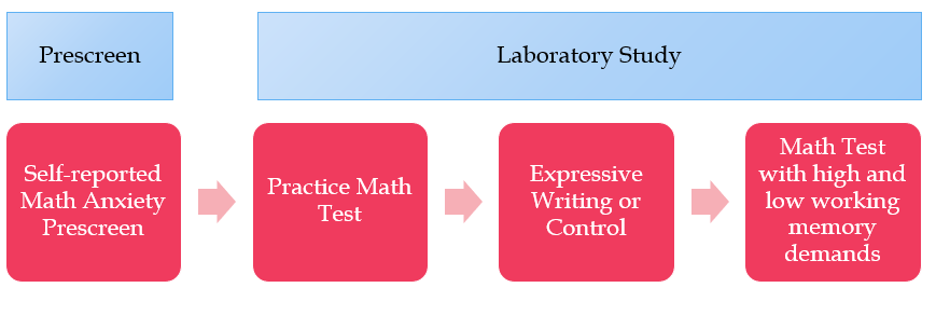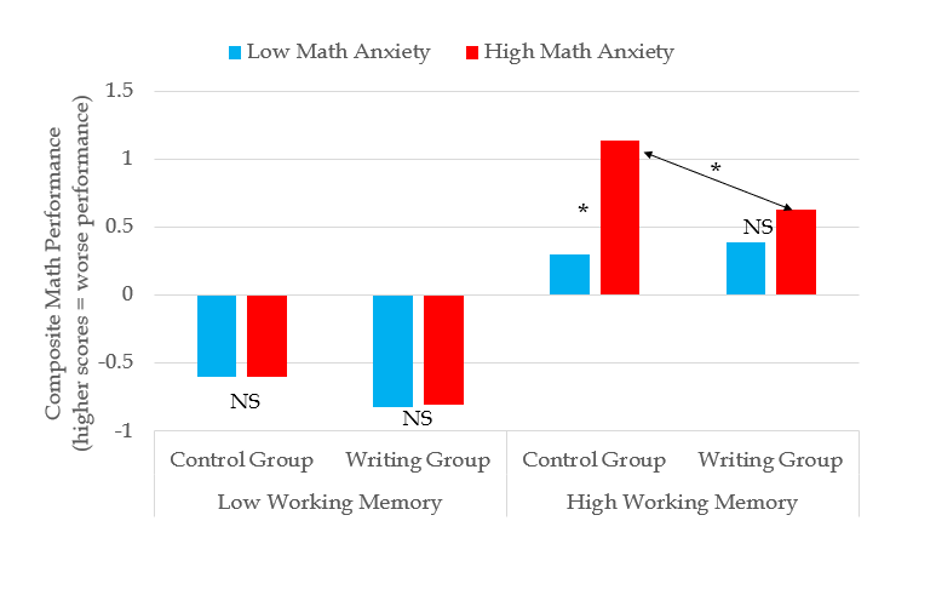Chapter 14 – Emotion Regulation
Impact of Expressive Writing in Academic Context
In a more recent study (Park et al., 2014), researchers investigated how confrontation in writing reduces the impact of test anxiety or math performance. Procedures are depicted in Figure 7 and the variables included are described below.
Math Anxiety Quasi-IV: Before the laboratory study, participants completed a self-report prescreen measure on their anxiety toward math tests. Based on their scores, students were divided into High Math Anxiety (HMA) or Low Math Anxiety (LMA) participant groups.
Within-Subjects IV: High and Low Working Memory Demand on Math Tasks: Researchers manipulated the amount of working memory that was used on arithmetic tasks (think algebra 1!). High demand math problems were more complex and included higher numbers whereas low demand included more simple operations and lower numbers. High demand math problems require more working memory, whereas low demand tasks require less working memory. Participants were shown the arithmetic calculations on a computer screen and asked to click one of two keys that indicated whether each math problem was solved correctly or incorrectly. When participants completed the math test, half the problems were high demand and half were low. Thus, all participants received high and low demand problems.
Between-Subjects IV: Control or Expressive Writing Group: In the control group, participants were instructed to wait for the researcher to return with documents. Participants in the writing group were instructed to write about their thoughts and feelings toward the upcoming math test they would take in the laboratory. Specifically, researchers instructed participants to (Park et al., 2014, p. 106):
After both groups waited 7 minutes, they completed the math exam.
For the procedures, all participants first completed a practice math test meant to increase their anxiety on the test. Then, participants were divided into the control or expressive writing group.
Composite Math Performance Dependent Variable: Math performance was measured as error rates. An error rate occurs when participants select the wrong answer – either by indicating the answer was correct when it was actually wrong OR the answer was wrong when it was actually correct. Beyond performance, researchers measured participants’ reaction time to correct answers. Shorter times indicated participants were faster to indicate whether the math answer was wrong or right. Researchers created a composite math performance score. For this composite, higher numbers indicate poorer performance. In other words, higher numbers indicate the participant had many errors and had a slow reaction time.
Figure 7
Procedures from Park et al. (2014)

Long Description
The image is a flowchart illustrating a study process divided into two main parts: “Prescreen” and “Laboratory Study.” The “Prescreen” section, on the left, is represented by a light blue rectangular box containing the word “Prescreen.” Connected by an arrow pointing right, the process transitions to the “Laboratory Study” phase. This phase is broken down into four red rectangular boxes aligned horizontally, each connected by right-facing arrows. The first red box reads “Self-reported Math Anxiety Prescreen,” the second “Practice Math Test,” the third “Expressive Writing or Control,” and the final box “Math Test with high and low working memory demands.”
Adapted from “The Role of Expressive Writing in Math Anxiety” by D. Park, G. Ramirez, and S.L. Beilock, 2014, Journal of Experimental Psychology: Applied, 20(2), p. 105-106. (https://doi.org/10.1037/xap0000013). Copyright 2014 by the American Psychological Association.
Figure 8 displays the results. Let’s look at the results for the high working memory math task on the right portion of the figure. Remember, in the high working memory task, the math questions were more complex and thus required more working memory to complete. Three important findings:
- In the control task, math anxious participants performed significantly worse on the math test than low anxious participants. This finding confirms what we already know – that anxiety impairs performance on tests.
- In the expressive writing group, performance was not different between the high anxious and low anxious participants. This means that after writing about thoughts and feelings about an upcoming event, anxious participants now are performing the same as low anxious participants. In other words, expressive writing is a good intervention for test anxiety! And writing closes the performance gap between students who experience and do not experience test anxiety. This finding is important for a second reason – it shows that expressive writing does not harm the performance of low anxious participants. There have been some suggestions that expressive writing for non-anxious students could actually increase their anxiety before the exam, having the reverse effect. But this finding suggests that assumption is not true.
As indicated by the arrow in Figure 8, high math anxiety participants performed significantly better on the exam after writing versus doing nothing before the exam. This finding is important because it shows that writing doesn’t just eliminate the gap between anxious and non-anxious students, but writing will also improve the performance on the test.
Figure 8
Influence of Math Anxiety, Writing Group, and Working Memory on Math Performance

Long Description
The image is a bar graph illustrating composite math performance in relation to math anxiety and working memory. The y-axis represents composite math performance, with higher scores indicating worse performance, and it ranges from -1 to 1.5. The graph includes data for low math anxiety (blue bars) and high math anxiety (red bars) across four categories: Control Group with Low Working Memory, Writing Group with Low Working Memory, Control Group with High Working Memory, and Writing Group with High Working Memory.
In the low working memory section, both anxiety groups have bars slightly below 0, labeled as “NS” indicating no significant difference. In the high working memory section, the low anxiety group has a blue bar near 0 for the Control Group and a positive bar for the Writing Group. The high anxiety group shows a significant increase in the Control Group, reaching above 1, marked with an asterisk, while the Writing Group shows a decrease to around 0.5, also marked with an asterisk. The graph includes arrows indicating significant differences between groups.
Adapted from “The Role of Expressive Writing in Math Anxiety” by D. Park, G. Ramirez, and S.L. Beilock, 2014, Journal of Experimental Psychology: Applied, 20(2), p. 108 (https://doi.org/10.1037/xap0000013). Copyright 2014 by the American Psychological Association.
Now, let’s look at the left portion of Figure 8. The left position represents low working memory math problems – those problems that are easier and thus require less working memory. For both the control and writing groups, we do not see significant differences between low and high math anxiety participants. In other words, all four participants groups are performing well on the simple math problems. Why is this important? Well, these nonsignificant findings tell us that math anxiety is more detrimental to performance on tasks that requires LOTS OF working memory. In other words, it’s not that test anxiety is going to affect performance on every single test and problem. Test anxiety is going to affect performance on DIFFICULT problems that require more working memory and more time to answer the problem.
These nonsignificant findings also give us some information about why confronting our emotional feelings and thoughts is a successful emotion regulation strategy. With confrontation, we are thinking about and processing our thoughts and feelings about the eliciting event – in this case the exam. What seems to be happening is that participants experiencing test anxiety are ruminating about their anxiety and negative emotions while taking the exam – which requires attentional resources. Because of the rumination, participants have less working memory capacity to actually think about the questions. By encouraging an effective regulation strategy before the exam, that frees up working memory space to actually focus on the math problems. As a note, work also suggests simply engaging in the type of thinking in these studies results in similar benefits (Rivkin & Taylor, 1999). In this study, participants were asked to think about a current stressor in their lives. Then, students were randomly assigned to think about and visualize their emotions about this event, to simulate ways to resolve the stressor, or a control group not given instructions. Participants who visualized their emotions reported more positive emotions, more active coping and better psychological well-being right after the manipulation and up to 1 week later. Interestingly, differences in physical symptoms were not found between groups.
Let’s discuss one more finding from this study. Park et al. (2014) analyzed the words the highly anxious participants used when engaging in expressing writing. They found that for anxious participants, a greater use of anxious, cause, and insight words was associated with better performance on the math task. These findings tell us that during the expressive writing, anxious participants were confronting and thinking about their negative emotions toward the upcoming test. In addition, the insight words suggest that participants might have been re-appraising the math test.

